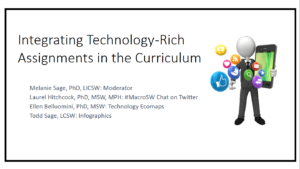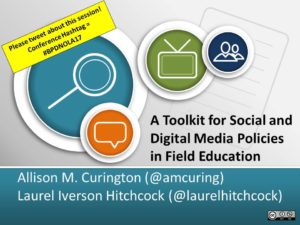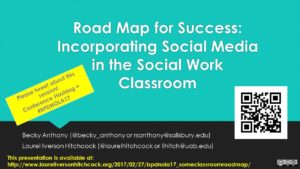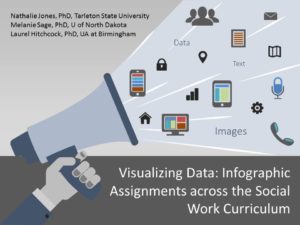Day Two of #SWDE2017 – Integrating Technology-rich Assignments in the Curriculum
 From April 12-14, 2017, the third annual Social Work Distance Education Conference was sponsored by Our Lady of the Lake University’s Worden School of Social Service in San Antonio, TX.
From April 12-14, 2017, the third annual Social Work Distance Education Conference was sponsored by Our Lady of the Lake University’s Worden School of Social Service in San Antonio, TX.
Melanie Sage & Todd Sage of the University of North Dakota, Ellen Belluomini of Dominican University, and I participated in a panel discussion about incorporating technology-based assignments in the social social work curriculum. We talked about three different types of technology-based assignments that can be incorporated into almost any classroom: Twitter Chats, Technology Assessments, and Infographics.
You can access a copy of the slides here: https://www.slideshare.net/laurelhitchcock/integrating-technologyrich-assignments-in-the-curriculum. We also have some assignment specific resources:
#BPDNOLA17 – The Social Media Toolkit goes on the road
 In November 2016, I had the pleasure of presenting with Allison Curington, Director of Field Education at the University of Alabama, about our Social Media Policy Toolkit at CSWE’s 2016 Annual Program Meeting in Atlanta, GA. Today, we are at BPD’s 2017 Annual Conference in New Orleans to share our work once again. We will be talking about a project that we have been working on for the past two years, a Toolkit for Social and Digital Media Policies in Field Education. Please join us at 11:00 AM in Bayside B at the Sheraton in New Orleans for our presentation. Allison and I started collaborating on this toolkit after many, many conversations about the growing use (and misuse) of social media in field education by students, educators and field supervisors. We saw that field directors were increasingly dealing with ethical and practical issues related to the use of social and digital media in field education, and we wanted to provide information and tools to help field directors raise awareness with students and field supervisors.
In November 2016, I had the pleasure of presenting with Allison Curington, Director of Field Education at the University of Alabama, about our Social Media Policy Toolkit at CSWE’s 2016 Annual Program Meeting in Atlanta, GA. Today, we are at BPD’s 2017 Annual Conference in New Orleans to share our work once again. We will be talking about a project that we have been working on for the past two years, a Toolkit for Social and Digital Media Policies in Field Education. Please join us at 11:00 AM in Bayside B at the Sheraton in New Orleans for our presentation. Allison and I started collaborating on this toolkit after many, many conversations about the growing use (and misuse) of social media in field education by students, educators and field supervisors. We saw that field directors were increasingly dealing with ethical and practical issues related to the use of social and digital media in field education, and we wanted to provide information and tools to help field directors raise awareness with students and field supervisors.
Based on feedback from CSWE and a Field Educator’s training at UA in January, we have updated our tools and hope to get even more feedback from our BPD colleagues before launching our toolkit. In our interactive workshop today, we plan to present on the toolkit and share one of the tools from the kit – Social Media Policy Checklist and Worksheet for Social Workers.
#BPDNOLA17 – Road Map for Success: Incorporating Social Media in the Social Work Classroom
 At BPD in 2016, I attended a wonderful session by Drs. Becky Anthony and Jennifer Jewell of Salisbury University titled Building student connection by utilizing social media in the social work classroom. They graciously wrote about this presentation in a blog post – Social Media How-To Guide for Social Work Educators. Today (Saturday, March 4th), Becky and I will be presenting about how we both are the using guidelines that she and Jennifer developed, giving examples from our own teaching and classroom assignments. Please join us at 8:00 AM in Bayside B at the Sheraton in New Orleans for our presentation.
At BPD in 2016, I attended a wonderful session by Drs. Becky Anthony and Jennifer Jewell of Salisbury University titled Building student connection by utilizing social media in the social work classroom. They graciously wrote about this presentation in a blog post – Social Media How-To Guide for Social Work Educators. Today (Saturday, March 4th), Becky and I will be presenting about how we both are the using guidelines that she and Jennifer developed, giving examples from our own teaching and classroom assignments. Please join us at 8:00 AM in Bayside B at the Sheraton in New Orleans for our presentation.
Here is a link to the slides from our presentation: https://www.slideshare.net/laurelhitchcock/bpdnola17-road-map-for-success-incorporating-social-media-in-the-social-work-classroom
Also, information about developing professional social media guidelines for the classroom can be found here.
Here is our abstract with the learning objectives:
#BPDNOLA17 – Visualizing Data: Infographic Assignments across the Social Work Curriculum
 Today is the third day (Friday, March 3rd) of #BPDNOLA17, and I am presenting with some of my favorite #swtech peeps, Dr. Nathalie Jones of Tarleton State University and Dr. Melanie Sage of the University of North Dakota, at 1:45pm in Bayside C at the Sheraton in New Orleans. We will be talking about an infographic assignment that we jointly developed and implemented with students at each of our campuses. The use of infographics for classroom assignments is becoming commonplace in higher education, although less is known about its use in social work education. Our workshop will review how we collaborated to develop, implement and evaluate an infographic assignment for courses across the social work curriculum.
Today is the third day (Friday, March 3rd) of #BPDNOLA17, and I am presenting with some of my favorite #swtech peeps, Dr. Nathalie Jones of Tarleton State University and Dr. Melanie Sage of the University of North Dakota, at 1:45pm in Bayside C at the Sheraton in New Orleans. We will be talking about an infographic assignment that we jointly developed and implemented with students at each of our campuses. The use of infographics for classroom assignments is becoming commonplace in higher education, although less is known about its use in social work education. Our workshop will review how we collaborated to develop, implement and evaluate an infographic assignment for courses across the social work curriculum.


